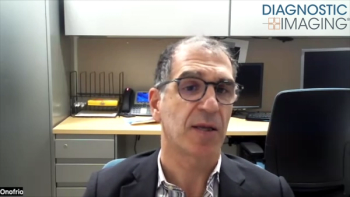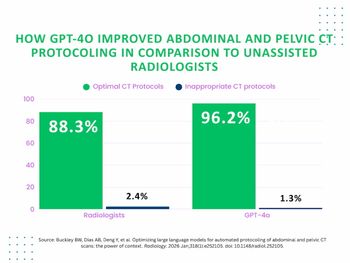
Innovation drives growth of hybrid imaging
Interest in multimodality imaging shows no sign of abating. New tracers are opening up the range of clinical applications, while novel technological solutions are paving the way for yet more modality marriages, according to speakers at Sunday’s special focus session on hybrid imaging.
Interest in multimodality imaging shows no sign of abating. New tracers are opening up the range of clinical applications, while novel technological solutions are paving the way for yet more modality marriages, according to speakers at Sunday's special focus session on hybrid imaging.
Prof. Liselotte Højgaard
Copyright European Society of Radiology
Prof. Liselotte Højgaard, director of clinical physiology, nuclear medicine, and PET at Rigshospitalet, University of Copenhagen, described the impact that PET/CT can have on clinical practice.
"Getting a PET/CT system in a nuclear medicine department is a little like getting a tiger instead of a dog," she said.
PET/CT has already proven itself to be particularly valuable in oncology. Imaging with the radiotracer fluorine-18 FDG can identify areas of abnormal metabolic behaviour, and the addition of CT homes in on the site of malignancy. Indications include malignant melanoma and lymphoma, and cancers of the head and neck, esophagus, breast, lung, and colon.
The development of new tracers may help PET/CT gain a stronger foothold in more clinical areas. For example, imaging with copper-64 ATSM may allow practitioners to identify hypoxic tumours that are difficult to treat with radiation. This information may be critical to radiotherapy planning. Dementia is another area where PET/CT looks set to play a greater role. The tracers carbon-11 PIB and fluorine-11 PIB look set to make this possible.
Højgaard now wants to see the evidence base catch up with PET/CT practice. Many meta-analyses demonstrating the clinical efficacy of PET have been published, but no such studies have been conducted into the value of PET/CT.
She would also like to see data on the cost-effectiveness of PET/CT. Such analyses should be performed by health economists, who would provide a rigorous and comprehensive assessment, rather than by radiologists, she said.
"We have seen an almost exponential rise in the use of PET/CT," she said. "I think we are now on the change of a curve in diagnostic imaging as a whole. In some areas, such as CT, this rise looks likely to continue. But some of the other techniques will demand cost-effectiveness proof of what we are doing. We will have to think cautiously about how to spend our money."
Prof. Torsten Kuwert, chair of nuclear medicine at the University of Erlangen in Germany, agreed that cost-effectiveness is an important consideration. He pointed out that if a hybrid imaging modality can reduce diagnostic uncertainty, then additional follow-up studies or invasive tests may not be necessary and money could be saved.
SPECT/CT could potentially make a significant difference to clinical practice, according to Kuwert. Approximately two million SPECT examinations are performed every year in Europe, making SPECT what he called the "imaging workhorse" of nuclear medicine. Evidence suggests, however, that moving to SPECT/CT could alter diagnoses in 30% of cases. In other words, 700,000 patients in Europe could benefit from the switch.
Kuwert has been using SPECT/CT in Erlangen since 2005. He presented several examples showing the advantages of hybrid imaging over separate scans. In the case of a patient with metastatic thyroid cancer, for example, neither SPECT not CT alone could pinpoint the site of malignancy. Fusing the two data sets revealed exactly where the surgeon should operate.
SPECT/CT is beneficial not just in oncology, though. It can also be used as a one-stop-shop for certain orthopedic investigations.
"The combination of SPECT and spiral CT has revitalised conventional scintigraphy," Kuwert said.
One concern with hybrid systems is that half of the scanner will always be lying idle. This is not necessarily the most cost-effective use of expensive imaging equipment. Why buy a 64-slice CT scanner if it is going to be welded to a gamma camera and used for only part of each imaging investigation? Hospital accountants may query whether this investment is truly worthwhile.
This issue should be less of a concern with PET/MRI, according to Dr. Robert Krieg from Siemens Medical Solutions. He outlined details of a prototype PET/MRI system, now installed at the University of Tübingen, Germany, that acquires data for the PET and MRI studies simultaneously.
"Our integrated PET/MRI system is a completely new machine," he said. "You simply cannot do this type of hybrid imaging with an existing PET system."
One of the main challenges posed by the integration of PET and MRI is photon attenuation. Components for the PET scanner must also be MR-compatible.
Fusing MRI with SPECT would pose additional technical difficulties, Kreig said. Lead collimators are an integral part of SPECT scanners. Alternative collimation technology would need to be devised for a SPECT/MRI machine.
The majority of today's hybrid systems are still essentially two separate technologies that have been joined together, said Prof. Angelika Bischof Delaloye, session moderator and chief of nuclear medicine at the University Hospital Vaudois in Lausanne, Switzerland. She questioned whether entirely new concepts would be needed to realise more substantial improvements to image quality.
The low resolution of PET images is one area that could benefit from a new way of thinking. One promising option is a technique known as virtual pinhole PET, Bischof Delaloye said. A description of this approach was published in the online Journal of Nuclear Medicine last month.
"Over the past few years, major progress has been made in imaging on the CT side," she said. "Now we need to improve our nuclear medicine instruments."
Newsletter
Stay at the forefront of radiology with the Diagnostic Imaging newsletter, delivering the latest news, clinical insights, and imaging advancements for today’s radiologists.




























